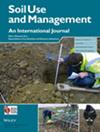Assessment of potential soil erosion in Mongolia based on the RUSLE model and RCP 8.5 scenario
IF 3.7
3区 农林科学
Q1 SOIL SCIENCE
引用次数: 0
Abstract
Due to its relatively high altitude and a continental climate, environmental issues related to soil erosion and land degradation more seriously affect the ecosystem and crop production in Mongolia. As detailed soil erosion and land degradation assessments have only been performed in some regions of Mongolia, the purpose of this study is to evaluate the soil vulnerability on a national scale and predict future soil erosion under climate change prior to establishing an appropriate management plan. The Revised Universal Soil Loss Equation (RUSLE) model was chosen for this study, which reflects geographic and climatic characteristics in a vast area as the Mongolian territory. We evaluated soil erosion using historical data from 1993 and 2013 and generated predictions in the near (2041‐2060) and far future (2061‐2080) periods under the RCP 8.5 scenario. The soil erosion rates were divided into six classes: very low, low, medium, high, very high and extreme. The total of 46,039 km2 of the Mongolian territory was classified as very high and extreme risk, which is predicted to increase up to 48,961 km2 and 51,769 km2, in the near and far future periods, respectively. At the national scale, most of the soil erosion appeared in bare area, as it covers more than 60% of the total area. Meanwhile, the highest soil erosion risk was expected in high mountain ranges and ecologically vulnerable regions of the Gobi Desert and steppe area. This study identifies three land cover types with high priority for management and areas that should be considered first in the sustainable national land use and soil management plans considering regional characteristics.基于 RUSLE 模型和 RCP 8.5 情景的蒙古潜在土壤侵蚀评估
由于蒙古的海拔相对较高且属于大陆性气候,与土壤侵蚀和土地退化相关的环境问题对其生态系统和作物生产的影响更为严重。由于只在蒙古的部分地区进行过详细的土壤侵蚀和土地退化评估,本研究的目的是在制定适当的管理计划之前,在全国范围内评估土壤的脆弱性,并预测气候变化下未来的土壤侵蚀情况。本研究选择了 "修订的通用土壤流失方程(RUSLE)"模型,该模型反映了蒙古幅员辽阔地区的地理和气候特征。我们利用 1993 年和 2013 年的历史数据对土壤侵蚀进行了评估,并在 RCP 8.5 情景下对近期(2041-2060 年)和远期(2061-2080 年)进行了预测。土壤侵蚀率分为六个等级:极低、低、中、高、极高和极端。蒙古 46 039 平方公里的领土被划分为极高风险和极端风险,预计在近期和远期将分别增加到 48 961 平方公里和 51 769 平方公里。在全国范围内,大部分水土流失出现在裸露地区,占总面积的 60%以上。同时,高山地区、生态脆弱的戈壁滩和草原地区的水土流失风险最高。本研究确定了三种需要优先管理的土地覆被类型,以及在考虑区域特点的可持续国家土地利用和土壤管理计划中应首先考虑的区域。
本文章由计算机程序翻译,如有差异,请以英文原文为准。
求助全文
约1分钟内获得全文
求助全文
来源期刊

Soil Use and Management
农林科学-土壤科学
CiteScore
7.70
自引率
13.20%
发文量
78
审稿时长
3 months
期刊介绍:
Soil Use and Management publishes in soil science, earth and environmental science, agricultural science, and engineering fields. The submitted papers should consider the underlying mechanisms governing the natural and anthropogenic processes which affect soil systems, and should inform policy makers and/or practitioners on the sustainable use and management of soil resources. Interdisciplinary studies, e.g. linking soil with climate change, biodiversity, global health, and the UN’s sustainable development goals, with strong novelty, wide implications, and unexpected outcomes are welcomed.
 求助内容:
求助内容: 应助结果提醒方式:
应助结果提醒方式:


